Mixing. Kneading. Pounding The Dough. #
This is the stage that scares many home bakers, but it shouldn't
Maybe you're worried about "kneading" and how it's too hard and takes too long. Heck, there's entire books written on how to avoid this step entirely.
I'm going to show you a method that's quick, easy and will save you time and refrigerator space too.
All we want to accomplish at this stage is to lengthen, strengthen and align the gluten in the dough. We'll accomplish this, not by hard kneading, but by easy stretching and folding.
Here's how to do it.
Find a Clean Counter and your Plastic Scraper #
You're going to get the counter temporarily dirty, so give yourself some space.
Take a Look at the Dough in the Bowl #
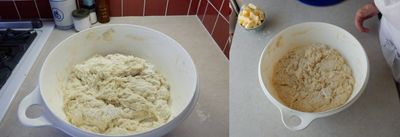
Dough before autolyse (left) and after 20 minutes (right). I've also changed counters. I need more room for this step!
See how it's flatter, smoother and firmer already? The autolyse worked! Much of the trouble of working with extremely sticky dough has been removed by the rest.
Pour the Dough onto the Counter #
Scrape out any dry bits that are still in the bowl too.
Save the bowl because we'll use it later.
Stretch and Fold for Five Minutes #
Pick up one end of the dough. Stretch it toward you and flip it over the rest of the dough. Stretch, and fold.

Stretch!
Pick up the dough on the side, so it turns 1/4 turn. Slap it down on the counter. Stretch it toward you, and fold.
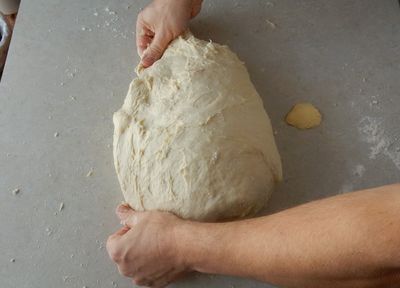
Fold!
Repeat the stretch, fold, turn, slap sequence for 5 minutes. Nice and slow, nice and gentle.
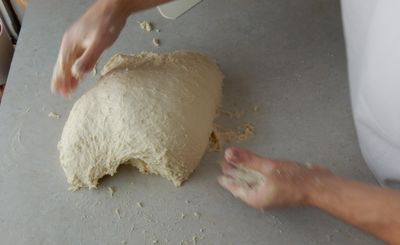
Pick it up with a 1/4 turn and do it again!
After 5 minutes of this, the dough will be much stronger and tougher to stretch out. Great job! Let it rest on the counter for a few minutes while you get a drink of water.
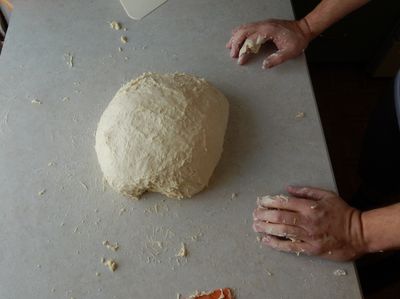
The dough ball after 5 minutes of stretching and folding
Refreshed? Good. Fold the dough and go back to stretching and folding for another 3-5 minutes.
The dough should be quite a bit stronger than when you started and all the butter completely absorbed in the dough.
That's it! You're done in under 10 minutes. Way to go!
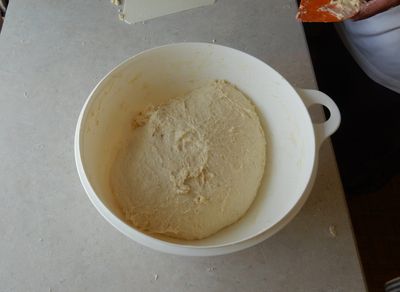
The dough has been stretched and folded for 8 minutes. Time for first fermentation.
Spray your mixing bowl with pan spray. Gently round your dough into a ball and place, seam side down, in the bowl.
Cover and place in a warm corner of your kitchen for 45 minutes.
Here's a tip. If you're baking during a Saskatchewan winter cold snap, your kitchen might be cold and drafty. Well, mine sure is. If this is the case, put the bowl in your oven with just the oven light on. This will make a cozy warm home for your dough during fermentation.
What Just Happened? #
We just finished all the hard work for our loaf of bread. By stretching and folding the dough, we continued to develop the gluten in the dough, strengthening and lengthening the protein chains.
Take a good look at your dough. It's still pretty rough, isn't it? If you pull on a corner of the dough, the gluten doesn't stretch like a balloon, it just breaks up.
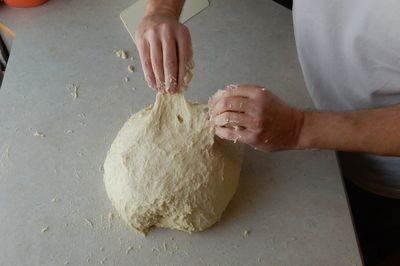
A 'short' mix. The gluten isn't developed enough to raise our bread. Yet!
At this stage, bakers say that the mix is 'short': the gluten isn't developed enough to raise your loaf.
We'll continue to strengthen the gluten during the next stage, Bulk Fermentation, which I'll cover in the next post.